Commercial Concrete Polishing Services
Polished Concrete May Be The Right Surface for You
If you’re the owner or manager of a commercial building with a large surface area, one of your primary concerns is likely how to create a safe, slip-resistant, durable floor that last for years, without having to spend a lot of money on constant maintenance, repairs, or replacing the floor - and polished concrete may be the best option for you.
Polished concrete is:
- Durable and long-lasting
- Non-absorbant, and protects from spills
- Doesn’t show scratches or scuffs
At Toronto Epoxy Pros, our expert polished concrete installers can help you every step of the way, including helping you determine whether this floor type - or something like epoxy - is the best choice for your building.
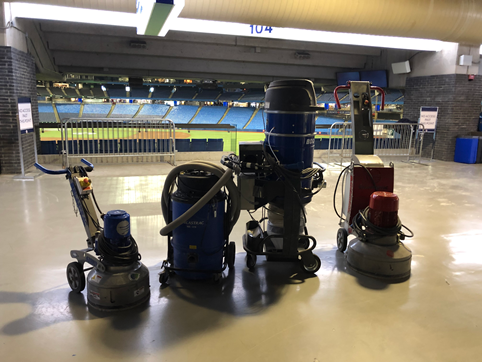
Polished Concrete Process
Polishing concrete involves 4 steps:
Determining Grinding Level
Different classes of diamond pads are used to grind down the concrete surface, creating the smooth, polished surface. How far you grind depends on the class of diamond you use, which affects how much of the stone within the cement you are exposing, and how much you are shaving it. You choose from 3 classes:
- Class 1: Uses the least abrasive diamond and goes just over the floor, which then has resin added and burnishing done. It exposes the least amount of aggregate, and polishes just the top or ‘cream’ layer of the concrete.
- Class 2: Uses two sets of diamonds - a more aggressive first and then a less aggressive (Class 1), which exposes more aggregate, but just the tips of the stones. This gives a salt & pepper look to the surface before the resin and burnishing is done.
- Class 3: Uses the most aggressive diamond or an entire coating removal, shaving the stones to see their diameter (stones are effectively cut in half), exposing bigger pieces of aggregate in the floor before resin and burnishing.
Grinding
This stage is the bulk of the work, in which we actually grind down the surface using the chosen class of diamond pad to smooth out the surface. Based on the class and desired smoothness level, as well as the amount of area that needs polishing, this stage can sometimes take a long time. We would also fix any small imperfections in the surface by grinding them down in this stage.
Resin Sealer
The now polished surface is polished with resin and at times densifiers, which strengthens and hardens the concrete. Once the densifier dries out entirely, the surface can be smoothed until it achieves that glossy-like appearance.
Burnishing
We then burnish the surface using a burnishing machine and a grit pad of a certain level (depending on the project). Higher grit pads create a glossier final look to the polished concrete surface.
Determining Grinding Level
Different classes of diamond pads are used to grind down the concrete surface, creating the smooth, polished surface. How far you grind depends on the class of diamond you use, which affects how much of the stone within the cement you are exposing, and how much you are shaving it. You choose from 3 classes:
- Class 1: Uses the least abrasive diamond and goes just over the floor, which then has resin added and burnishing done. It exposes the least amount of aggregate, and polishes just the top or ‘cream’ layer of the concrete.
- Class 2: Uses two sets of diamonds - a more aggressive first and then a less aggressive (Class 1), which exposes more aggregate, but just the tips of the stones. This gives a salt & pepper look to the surface before the resin and burnishing is done.
- Class 3: Uses the most aggressive diamond or an entire coating removal, shaving the stones to see their diameter (stones are effectively cut in half), exposing bigger pieces of aggregate in the floor before resin and burnishing.
Grinding
This stage is the bulk of the work, in which we actually grind down the surface using the chosen class of diamond pad to smooth out the surface. Based on the class and desired smoothness level, as well as the amount of area that needs polishing, this stage can sometimes take a long time. We would also fix any small imperfections in the surface by grinding them down in this stage.
Resin Sealer
The now polished surface is polished with resin and at times densifiers, which strengthens and hardens the concrete. Once the densifier dries out entirely, the surface can be smoothed until it achieves that glossy-like appearance.
Burnishing
We then burnish the surface using a burnishing machine and a grit pad of a certain level (depending on the project). Higher grit pads create a glossier final look to the polished concrete surface.
Polished Concrete Benefits & Features
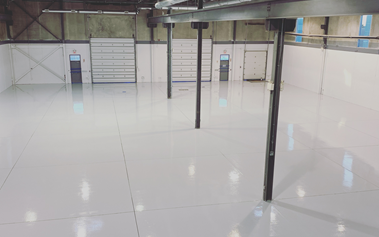
Durable & Long Lifespan
Polish One Time & It’s Done
A polished concrete floor will last for years - even decades - and will feel like new even after a long time of regular wear and tear. With the one-time polishing, you’ll invest an upfront cost, and see it pay off by lasting years longer than other solutions, saving you money in the long run. Generally only requiring an additional burnish to shine it up again years down the road.

Densifying Strengthens the Floor
Installation Makes the Floor Stronger - Not Weaker
The densifying stage of concrete polishing actually strengthens the floor, unlike other installations that wear down the surface or weaken it. This is especially great for large commercial areas that experience a lot of pressure on the surface with foot traffic, heavy machines, or a lot of shelving.
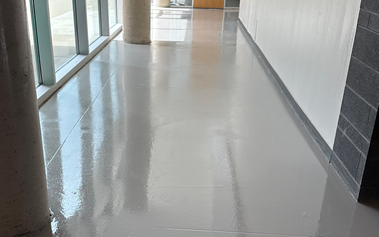
Doesn’t Show Scratches or Scuffs
Keep the Glossy Sheen For Years
A polished concrete floor will remain glossy and shiny for many years, and won’t show damages in the floor as a result of regular use. Foot traffic, heavy machinery, scratches, or knicks won’t show on the surface, and are less likely to penetrate the polished concrete than most flooring surfaces.
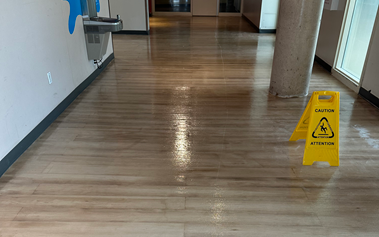
Easy to Clean & Maintain
Don’t Spend More on Long-Term Maintenance
Unlike other types of floor finishes, a polished concrete surface is one of the easiest to clean. It’s ultra-smooth, so can often just be swept, mopped, and wiped with microfibre cloths. Long-term costs will stay lower, as you won’t need to pay for speciality cleaning or maintenance.
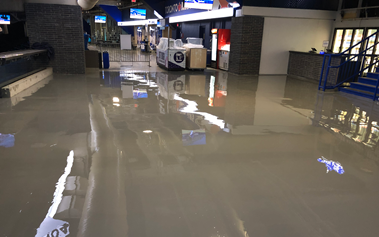
Reduces Allergens, Absorbency, & Damages
Maintain the Same Quality From Day 1
Polished concrete finishes are eco-friendly and don’t contain harmful chemicals, which helps reduce allergens and create a healthier space.They are also non-absorbent, so when spills happen, they will remain on the top of the slick surface, rather than penetrating deep and creating mold or mildew build up. The quality of the polished floor won’t deteriorate quickly, so even 5 years later, it will still look new.
How to Choose a Polished Concrete Installer
Insured, Accredited, & Well-Reviewed
A concrete polisher should come with liability insurance in case anything goes wrong during the project, and should have testimonials or reviews (especially photos) of completed projects to demonstrate the quality of their work.
Experts Making Recommendations
A good concrete polisher should be experienced enough with additional materials and flooring types to make specific recommendations to you about your unique space. Maybe epoxy is better than polished concrete for you, or you need concrete refinishing first, and they should be able to make that recommendation.
Proper Quoting & Pricing Process
Make sure the company you choose will quote you on the work beforehand, and ask the right questions (square footage, state of the concrete surface, are there any damages?, etc.) to give you a more accurate price range, and then offers a fair price for the work.
Why Work with Toronto Epoxy Pros?

Insured & WSIB-Certified
Our concrete polishing installers will bring peace of mind to your project, and help you with the unique needs of your project the whole way through. You can trust our work, as we’re WSIB-certified, and have $2 million liability insurance coverage for all projects.

Concrete Polishing Experts
We’ve completed numerous concrete polishing projects, and bring installers with years of experience so you can feel confident in the work on your floor being completed to your exact expectations, and on time, with the best recommendations for your needs taken into account before we even begin.

Fair Concrete Polishing Prices
We offer competitive pricing for concrete polishing services, and we know how to maximize efficiency and reduce installation time to create the perfect balance of a job well done, but quickly and within your budget.
Polished Concrete Floor Cost
Top 5 factors that affect concrete polishing cost
The cost to have polished concrete depends on a number of things, including how large the area is, the state of the concrete prior to beginning, and what you want the final appearance to look like.
The most common factors that affect the cost of concrete polishing are:
- The amount of damages in the floor, like large cracks, dents, scuffs, etc. that may need to be repaired or refinished prior to beginning the polishing.
- What class of diamond pad you want to use, which affects how far the concrete is grinded down, and how much of the lower levels of concrete are exposed.
- How smooth you want the final surface to be, which can increase grinding time, resin application, or burnishing time.
- If you want the surface to be strengthened with a densifier.
- Requiring overtime hours to meet extreme project timelines.
Is concrete polishing expensive?
Concrete polishing can be expensive depending on how large the area is (for example, large commercial warehouses or buildings), and it tends to have a higher upfront cost. However, the upfront cost is comparable to other flooring types, and the long-term costs of polished concrete are significantly lower than most other flooring types.
Roughly, what do polished concrete floors cost per square foot?
The typical cost of polished concrete floors is $5.50-$7.00 per square foot, but each project is unique, and there are many variables that can affect the overall price, and sometimes, the cost per square foot can be lower if the amount of square footage is higher.
Polished Concrete vs Epoxy: Which Is Best?
Polished concrete is a process by which concrete is diamond grinded down to create a smooth, easy-to-clean, and durable surface, while epoxy is a resin that is poured over a surface (usually concrete) to create a non-slip, non-absorbent, anti-conductive, anti-allergen and bacterial growth surface that is extremely long-lasting and easy to maintain.
Truthfully, neither is ‘best’ - it really depends on the area you are working with, and what occurs within that area. Polished concrete is great for areas like big box stores that have a giant surface area, shelving and constant foot traffic, and need to be cleaned regularly. Epoxy is great for a number of niche spaces like commercial kitchens and restaurants, retail showrooms, or places where spills occur like factories and warehouses.
You should discuss your needs with a flooring installation expert who can identify the best flooring type for you. Polished concrete may be the best way to go, but you may find that epoxy might be the right choice for you as well.
What Areas Benefit Most from Polished Concrete Floors?
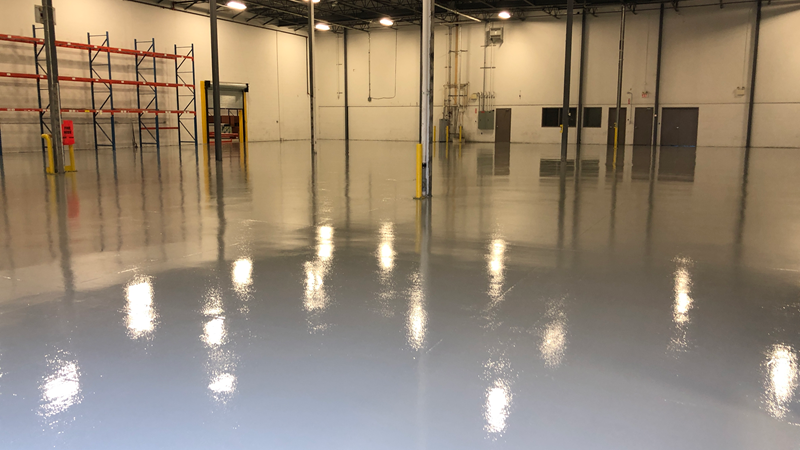
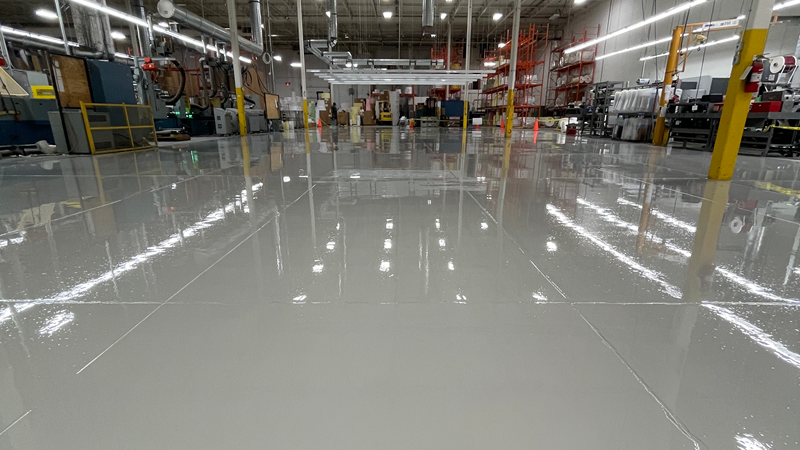
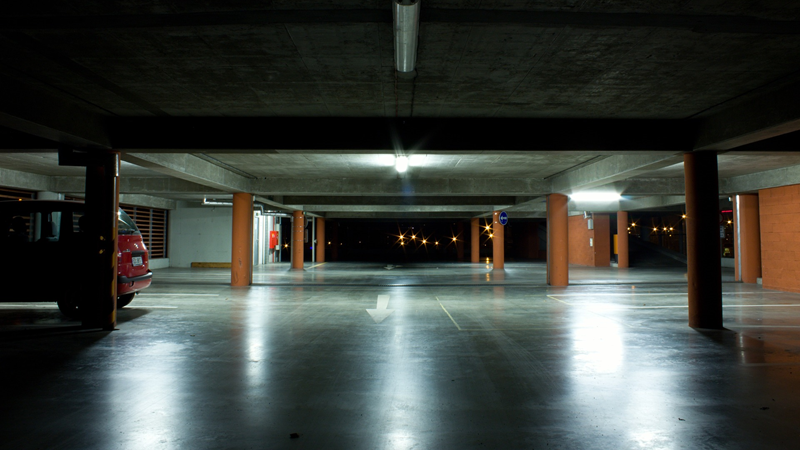
Polished Concrete Floors FAQs
What is polished concrete exactly?
Polished concrete is a flooring surface type made of concrete, but ground down to create a smooth surface and top layer that looks shiny like glass, and is better for indoor surfaces like retail stores. Regular concrete is poured into an area while polished concrete is then grinded with machinery to create a new type of surface.
What is concrete polishing and how is it done?
Concrete polishing is the technique used to achieve a polished concrete floor type, and is accomplished through the use of different classes and ‘grits’ of diamond grinding pads to grind down the layers of the concrete until a smooth top layer is created. Resin and burnishing is also done on the top layer to make it even smoother.
Sealed concrete vs polished concrete: what’s the difference?
Sealed concrete doesn’t involve any grinding like polished concrete, but instead involves pouring a sealer to the top layer of the concrete to create a similar glossy finish. Sealed concrete floors are less slippery, low-maintenance and easy-to-clean, and more anti-microbial than polished concrete floors, but they are also more difficult to repair if damaged, are sometimes not as high-quality (depending on your installer and their products), and have a shorter lifespan than polished concrete.
When are polished concrete floor finishes best for an area?
If you own or manage a big building with a lot of square footage, have heavy machinery or a lot of foot traffic, and want to keep long-term maintenance costs as well as overall lifetime costs lower, polished concrete is a great option for you.
If your building is prone to spillages (because you work with food, liquids, or chemicals), you want an anti-conductive surface (because you work with electric machinery), or you need a more antimicrobial surface (because you have to abide by sanitation or industry standards), then polished concrete may not be the right choice.
How much downtime should I expect for concrete grinding and polishing?
The downtime for concrete polishing will depend on the size of the area and the type of floor being polished. Surface condition and preparation requirements can change the duration of the project as well. Each project is unique.
How do you clean polished concrete floors, and is it easy?
Polished concrete floors are not difficult to clean, and in fact, because of their smooth, glass-like surface, they are easier to clean than many other flooring types. They can typically be kept up very well with simple sweeping, vacuuming, or mopping, and won’t show scuffs or minor damages over time.
Is polished concrete slippery, especially when wet?
Polishing concrete does create an ultra-smooth surface which is relatively slick, and can sometimes be slippery, but is more likely to only become slippery if wet, as it is non-absorbent, so water or other liquids will remain on the surface until cleaned up. The slipperiness of polished concrete is relative to other flooring options: compared to an epoxied floor for example, a polished concrete floor is more slippery, but compared to vinyl or wood flooring, it is not.
What are the biggest polished concrete floors pros and cons?
The biggest polished concrete floor pros are:
- Easy-to-clean with very basic, regular cleaning methods
- Reduced allergens and dust build up
- Lower long-term costs, as they don’t need to be maintained
- Durable, and long-lasting
- Appearance looks shiny and clean, even over time
- Non-absorbent, and protects floor damage from spills
Alternatively, polished concrete floors might not be for you if:
- More susceptible to moisture penetration
- Not as cost effective for large square footage areas compared to epoxy
- Can become slippery when wet
- Initial upfront cost is higher than some flooring solutions
- Can only look ‘one way’ and can’t be customized with colour or flaked options
- Not as suitable for areas with salt exposure
Is Toronto Epoxy Pros insured?
Yes, our concrete polishing installers are certified under the Workplace Safety and Insurance Board (WSIB), and under our $2 million liability insurance coverage.